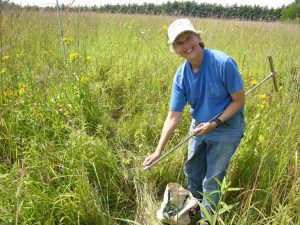Ecological research is undertaken at Fermilab to increase knowledge of existing ecosystems, to track individual species of interest, and to inform regulatory obligations.
Ecological Research
Ecological research is undertaken at Fermilab to increase scientific understanding of ecosystems, habitat restoration practices, and communities or species of interest. Academic researchers, scientists and others may submit proposals for research projects to Fermilab through the National Environmental Research Park (NERP) program. Proposals are reviewed by the Fermilab Ecological Land Management (ELM) Committee in cooperation with the Fermilab Roads and Grounds Department to ensure that the proposed work is compatible with the mission of the laboratory and the ELM plan.
In a world with a changing climate it is important to study how and why environmental changes are occurring so that we can adapt and plan for the future. Fermilab’s large site offers many types of habitat across its 6,800 acres that can be potentially used for studies. These include prairies, savannas, woodlands, wetlands, old fields and active agricultural fields. In addition, plant and animal communities are rich and diverse, and ongoing prairie restorations span in age from 4 years to over 45 years of existence. Quality of habitats range from relatively undisturbed (remnant) to degraded thereby providing an opportunity to study various aspects of resiliency and adaptability in the natural environment.
In the past, researchers from Argonne National Laboratory have conducted several studies related to climate change including bioenergy experimental plots and the investigation of carbon dioxide and nitrogen fluxes in terrestrial ecosystems. The results of these studies further our understanding of environmental systems and opportunities to effect change.
NERP related project funding is to be provided by the researcher or research group. Fermilab only provides the research site. Interested researchers should contact the NERP coordinator and consult the NERP Handbook (below) for details.
Ecosystem Monitoring
Monitoring is as critical to sound ecological land management as is restoring habitat. Habitat restoration creates niche space and resources for plants and wildlife and monitoring of those organisms informs success of habitat restoration. These two aspects rely on each other and land managers work hard to understand results and adapt management strategies accordingly.
While plant surveys measure the success of over seeding and species enrichment, additional measures of restoration success may be assessed by measuring wildlife response. If baseline surveys exist for both plant and animal communities, one can measure change in species richness and floristic quality index over time. Establishing goals for plant community diversity and conservation targets for wildlife populations are ways to test if restoration methods are setting the correct trajectory for achievement.
Results from various research projects also are used to construct GIS layers that indicate relative ecological values and habitat locations. This information is available to laboratory planners and project developers to improve decisions that may have consequences for natural areas.



